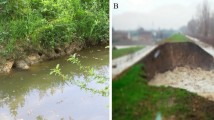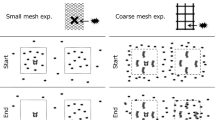Abstract
The ghost crab Ocypode ceratophthalma (Pallas) creates burrows of variety shapes at different ages. Juveniles (mean carapace length 11 mm) produced shallow J-shaped burrows, which incline vertically into the substratum (mean depth 160 mm). Larger crabs (17–25 mm carapace length) have Y-shaped and spiral burrows (mean depth 361 mm). These Y-shaped burrows have a primary arm, which extends to the surface forming the opening, and a secondary arm which terminates in a blind spherical ending. The two arms join in a single shaft and end with a chamber at the base. The secondary arms and chambers are believed to be used for mating or as a refuge from predation. The spiral burrows have spiral single channel ending in a chamber. Older crabs (mean carapace length 32.6 mm) had simple, straight single tube burrows, which inclined into the substratum at mean of 73° and had a mean depth of 320 mm. During summer daytime periods, the burrows shelter the crabs from heat and desiccation stress. The sand surface temperature at the burrow opening was ~48 °C but temperatures inside the burrows can drop to 32 °C at a depth of 250 mm. Variation in the burrow architecture with crab age appears to be related to the crab’s behaviour. Juvenile crabs have smaller gill areas and move out of the burrows regularly to renew their respiratory water and, as a result, they do not need a deep burrow. Larger crabs, in contrast, can tolerate prolonged periods without renewing their respiratory water and therefore create deeper and more complex burrows for mating and refuges.
Similar content being viewed by others
References
F. Barros (2001) ArticleTitleGhost crabs as a tool for rapid assessment of human impacts on exposed sandy shores Biological Conservation 97 399–404 Occurrence Handle10.1016/S0006-3207(00)00116-6
C. J. R. Braithwaite M. R. Talbot (1972) ArticleTitleCrustacean burrows in the Seychelles, Indian Ocean Palaeogeography, Palaeoclimatology, Paleoecology 11 265–285
B. K. K. Chan K. J. Caley (2003) Hong Kong Field Guides 4: Sandy Shores Wanli Book Co Hong Kong
A. Chakrabarti (1981) ArticleTitleBurrow pattern of Ocypode ceratophthalma (Pallas) and their environmental significance Journal of Paleontology 187 113–130
J. H. Christy (1982) ArticleTitleBurrow structure and use in the sand fiddler crab, Uca pugilator (Bosc) Animal Behaviour 31 687–694
Farrow, G. E., 1971. Back reef and lagoonal environment of Aldabra Atoll, distinguished by their crustacean burrows. In Stoddart, D. R. & C. M. Yonge (eds), Regional Variation in Indian Ocean Coral Reefs. Proceedings of the Symposium of the Zoological Society of London: 455–500
R. W. George (1982) The distribution and evolution of the ghost crabs (Ocypode spp.) of Hong Kong with a description of a new species B. S. Morton C. K. Tsang (Eds) Proceedings of the First International Marine Biological Workshop: The Marine Flora and Fauna of Hong Kong and Southern China, Hong Kong, 1980 The Hong Kong University Press Hong Kong 185–194
I. Hayasaki (1935) ArticleTitleThe burrowing activities of certain crabs and their geologic significance American Midland Naturalist 16 99–103
G. W. Hill R. E. Hunter (1973) ArticleTitleBurrows of the ghost crab Ocypode quadrata (Facricius) on the Barrier Islands, south-central Texas coast Journal of Sedimentary Petrology 43 24–30
S. Kaehler G. A. Williams (1996) ArticleTitleDistribution of algae on tropical rocky shores: spatial and temporal patterns of non-coralline encrusting algae in Hong Kong Marine Biology 125 177–187 Occurrence Handle10.1007/BF00350772
B. Morton J. Morton (1983) The Seashore Ecology of Hong Kong Hong Kong University Press Hong Kong
Morton, B., G. A. Williams & S. Y. Lee, 1996. The Benthic Marine Ecology of Hong Kong. A Dwindling Heritage? In Coastal Infrastructure Development in Hong Kong: A Review. Hong Kong Government, Hong Kong: 233–267
Takahashi, S., 1932. On the burrows of Ocypode ceratophthalma Fabricius. Kwagaku 2: 329–335 (in Japanese)
R. B. Weinstern (1995) ArticleTitleLocomotor behaviour of nocturnal ghost crab on the beach: focal animal sampling and instantaneous velocity from three dimensional motion analysis Journal of Experimental Biology 198 989–999
Author information
Authors and Affiliations
Corresponding author
Rights and permissions
About this article
Cite this article
Chan, B.K.K., Chan, K.K.Y. & Leung, P.C.M. Burrow Architecture of the Ghost Crab Ocypode ceratophthalma on a Sandy Shore in Hong Kong. Hydrobiologia 560, 43–49 (2006). https://doi.org/10.1007/s10750-005-1088-2
Received:
Revised:
Accepted:
Issue Date:
DOI: https://doi.org/10.1007/s10750-005-1088-2




